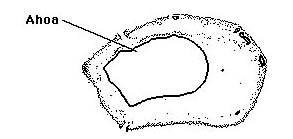back *****************VOLUME 18 page 7 ***************** page 1
FIELD NOTES
Friday 10/05/91
*****After two days of steady drizzle the rain let up this afternoon and I managed to at last recheck the Ahoa sites, these I had searched last week before they had been planted and now the potatoes were already in the ground and starting to sprout. We have been concentrating on these sites for the last month, after their first ploughing of the season. Some of the artifacts that have been recovered are detailed in Volume 17 and the more recent discoveries are presented here.
*****Last Saturday I made a quick search of ATIAHARA #3 which had been just ploughed and found little (a 3C fragment with a pecked shoulder and well ground back, and one well made branch coral file, both from the midden zone). Today I made a more thorough search in the hopes of finding fishhooks but found really nothing, the field still in a ploughed only condition. ATIAHARA #4 was ready for planting having been finely tilled, it was only ploughed on my last search when I found an interesting butt fragment probably from a 3Ga as well as a large piece of worked pearl shell. Now the fine tilling had covered up a lot of the heavier objects and only a few objects were exposed by the light rain. However a serious search turned up two 4Aa fragments in the southwest corner. One, a finely pecked butt fragment, where all of the poll as well as the horn had been pecked, also the sides and posterior surface ground, this fragment derives from a much perfectioned specimen. The second is from the mid-section of a virtually unpecked specimen which has also been ground, thus the two being rather different extremes in the same type. Somewhat closer to the road, I found a rather curious but thoroughly broken adze. Originally this small adze was so extensively ground that almost all scars had been eliminated, a shallow shoulder is found ground into place. About half of the adze is missing (the left side) and the diagrammatic reconstruction a simple matter, however the classification of this adze is another matter. The shoulder cross section is highly trapezoidal, the front convex transversely (see Diagram 18.20).
*****From here on to ATIAHARA #5 where the potatoes have been planted and the rows hoed, there is little left on the large scale, however I managed to find a fishhook fragment (bend) and a well as a finely finished blade from an adze which could perhaps be similar to the fragment from ATIAHARA #4.

*****Finally, I searched AHOAPOFATU #1,(Ahoa) which was now planted and a few of the plants sprouting, the conditions were ideal for looking for the smaller objects such as fishhooks, however I searched long and hard without finding a single one, but was rewarded instead with a number of other artifacts. One small
pearl-shell fishhook blank was found about 30 meters from the road, also a small shell adze, or scraper. A small unfinished adze blank was recovered last Saturday and today yet another, both quite interesting examples of quick and efficient, economical chipping of small flakes. A third unfinished fragment is illustrated in Diagram 18.38 this is a plano-convex form. Not far from the test pit #1 (see map 18.2a) site I recovered a very pointed branch coral file and mid field a square cross sectioned fragment very similar to another fragment also from AHOAPOFATU and illustrated in Volume 13 (page 130 and Appendix A) the two fragments both ground, are unique in their cross section which is unlike most known Tubuai adze forms (Diagram 18.22).
*****The best discovery of the day came at last, on my final pass out of the rows to return home. After three hours of concentrated searching my eyes were as tired as my legs and it was rather a bit of luck that I even bothered to check a rather smooth looking, light grey flake that somehow caught my attention. It turned out not to be a flake at all but rather a part of the bevel of a small chisel hiding below the surface. This unbroken, finished artifact, is illustrated in Diagram 18.14 In colour and from the style of the chipping (deep scoop scars) I would guess it to be one of the oldest artifacts recovered from this site. These small chisels are exceptionally rare, especially unbroken and diagnostically invaluable in as much as that from this complete specimen certain of the broken un-classified fragments may be recognized as being of the same type.
